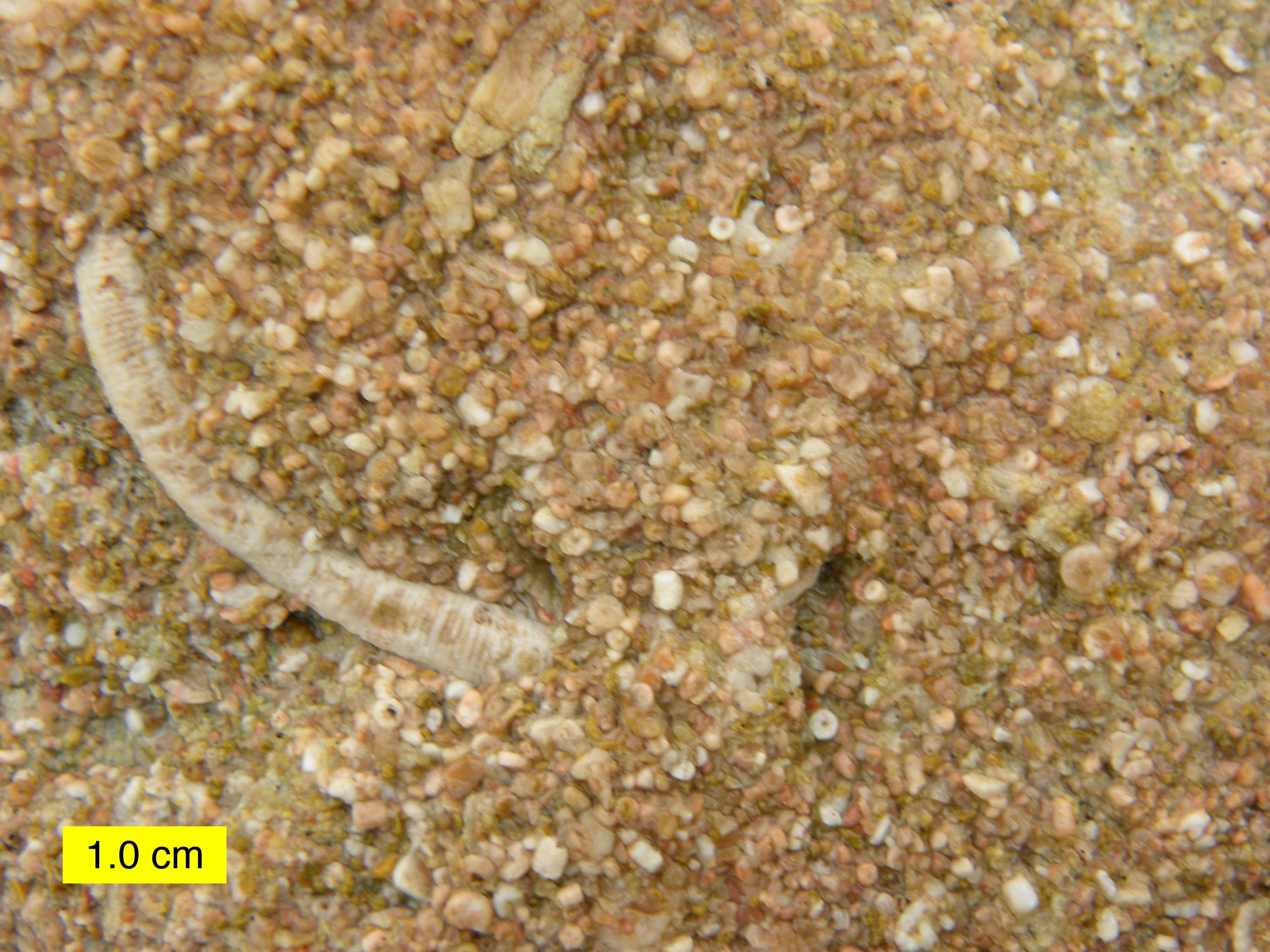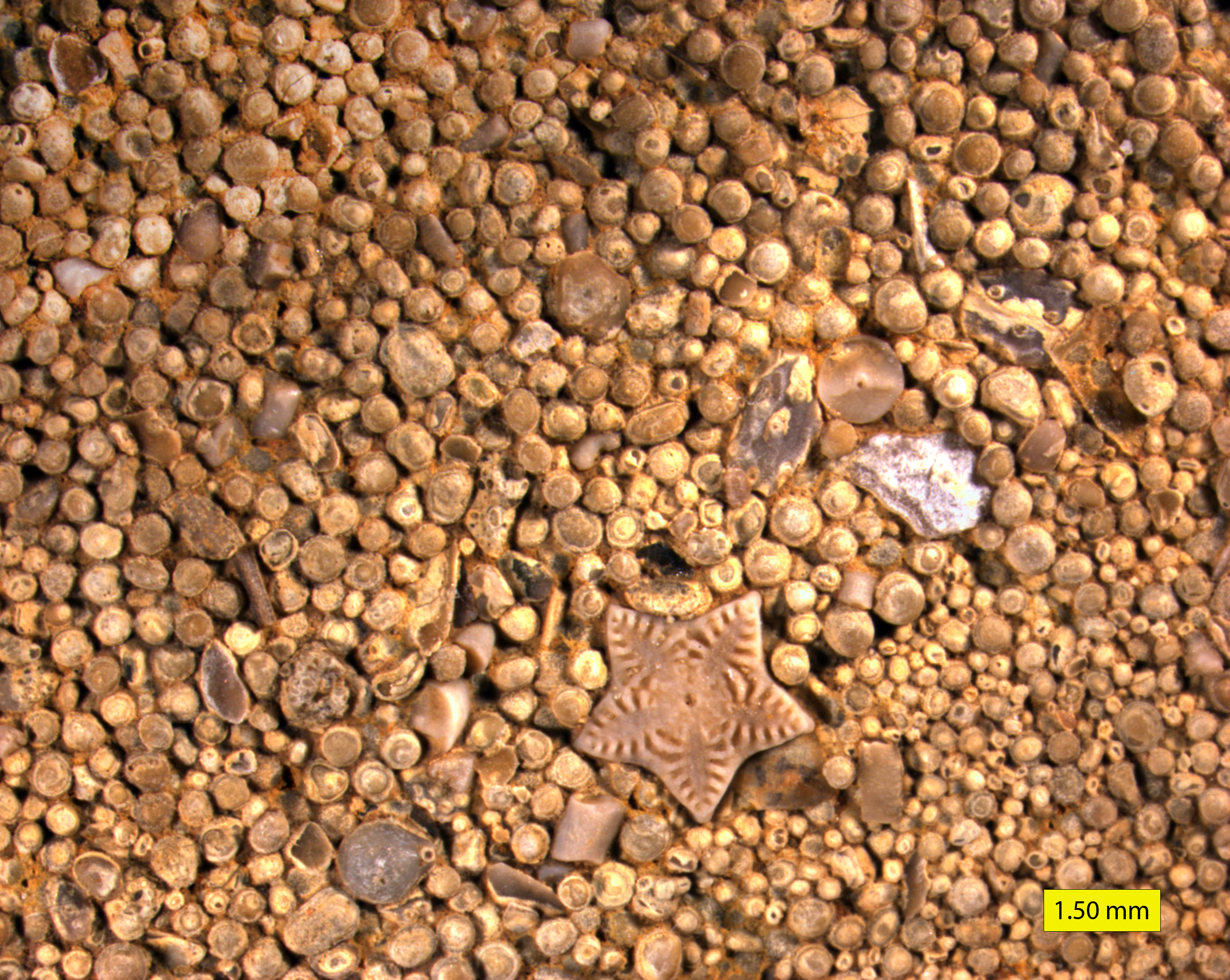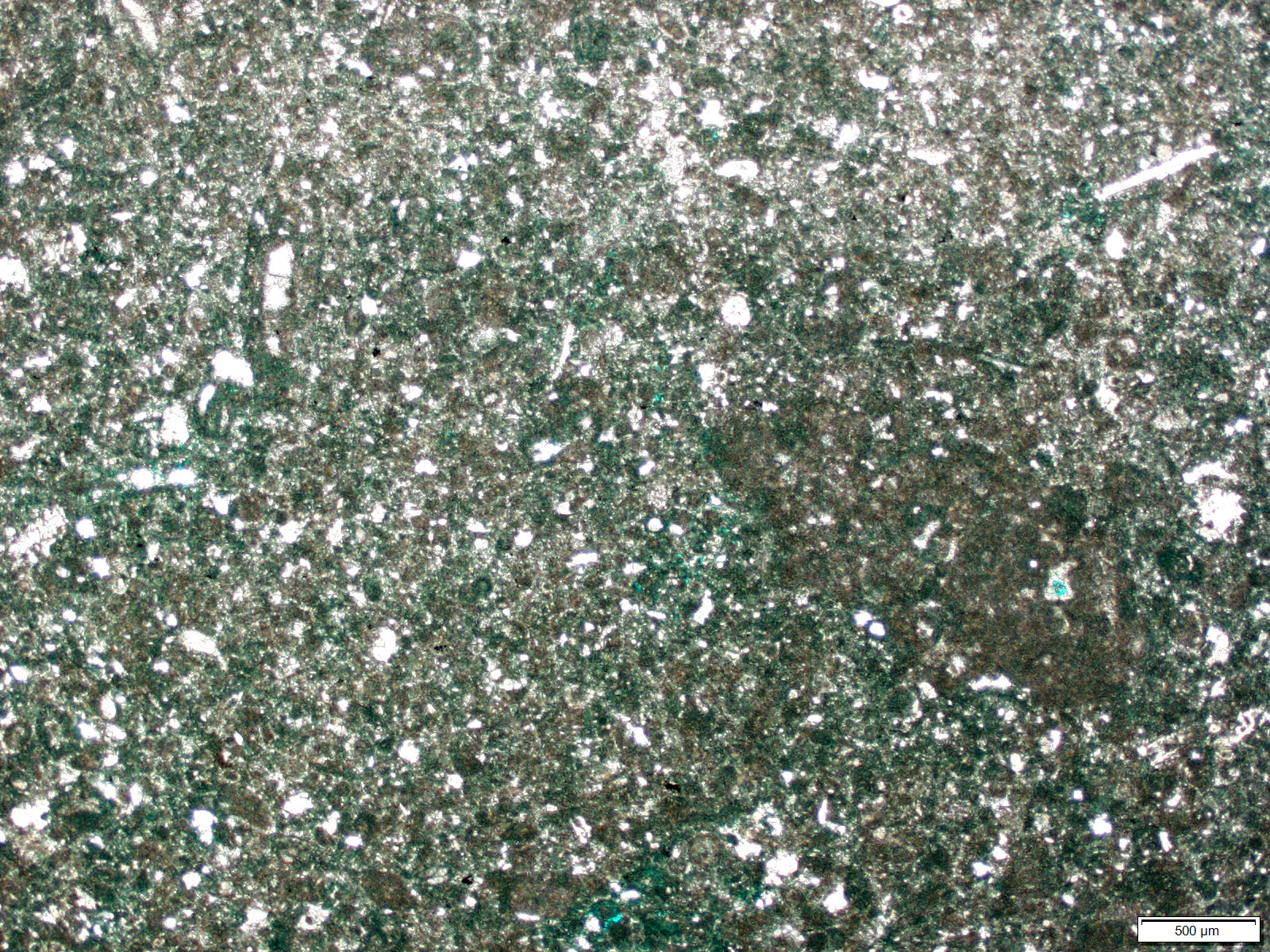Dunham classification on:
[Wikipedia]
[Google]
[Amazon]


 The Dunham classification system for
The Dunham classification system for
 evidence that the sediments were organically-bound at the time of deposition
On the basis of these criteria, the following four classes were defined:
; Mudstone : a mud-supported carbonate rock containing <10% grains
; Wackestone : a mud-supported carbonate lithology containing >10% grains
; Packstone : a grain-supported fabric containing 1% or more mud-grade fraction
; Grainstone : a grain-supported carbonate rock with <1% mud.
Recognising that these classes did not encompass all carbonate lithologies, Dunham defined two additional classes within his scheme:
; Boundstone : where there is any evidence that the carbonate sediments were bound at the time of deposition
; Crystalline
evidence that the sediments were organically-bound at the time of deposition
On the basis of these criteria, the following four classes were defined:
; Mudstone : a mud-supported carbonate rock containing <10% grains
; Wackestone : a mud-supported carbonate lithology containing >10% grains
; Packstone : a grain-supported fabric containing 1% or more mud-grade fraction
; Grainstone : a grain-supported carbonate rock with <1% mud.
Recognising that these classes did not encompass all carbonate lithologies, Dunham defined two additional classes within his scheme:
; Boundstone : where there is any evidence that the carbonate sediments were bound at the time of deposition
; Crystalline 
 To address the issue of coarse-grained allochthonous limestones (lithologies where >10% of the components are >2 mm in diameter), Embry and Klovan proposed the introduction of two further new classes:
; Rudstones : textures where the >2 mm grain-size fraction supports the framework
; Floatstones : matrix-supported textures with the >2 mm grains appearing to 'float' in a finer-grained matrix
As with the original Dunham classification, modifiers should be employed to enhance the classification. Additionally, the class names should be employed as textural modifiers to describe the matrix. Embry and Klovan also redefined 'mud matrix' as material with a diameter of <30 μm.
Following the wide adoption of the Embry and Klovan (1971) modifications, the Dunham Classification system is typically referred to as the modified Dunham Classification System''
To address the issue of coarse-grained allochthonous limestones (lithologies where >10% of the components are >2 mm in diameter), Embry and Klovan proposed the introduction of two further new classes:
; Rudstones : textures where the >2 mm grain-size fraction supports the framework
; Floatstones : matrix-supported textures with the >2 mm grains appearing to 'float' in a finer-grained matrix
As with the original Dunham classification, modifiers should be employed to enhance the classification. Additionally, the class names should be employed as textural modifiers to describe the matrix. Embry and Klovan also redefined 'mud matrix' as material with a diameter of <30 μm.
Following the wide adoption of the Embry and Klovan (1971) modifications, the Dunham Classification system is typically referred to as the modified Dunham Classification System'' It can be summarized as follows:
.
It can be summarized as follows:
.
Dunham, R.J. (1962) Classification of carbonate rocks according to depositional texture. In: Classification of Carbonate Rocks (Ed. W.E. Ham), Am. Assoc. Pet. Geol. Mem., 1, 108–121.
{{cite journal , last1=Wright , first1=V.P., year=1992 , title=A revised Classification of Limestones , journal=Sedimentary Geology , volume= 76 , issue= 3–4, pages=177–185 , doi=10.1016/0037-0738(92)90082-3
Sedimentary rocks
Limestone
Petrology


 The Dunham classification system for
The Dunham classification system for carbonate
A carbonate is a salt of carbonic acid (H2CO3), characterized by the presence of the carbonate ion, a polyatomic ion with the formula . The word ''carbonate'' may also refer to a carbonate ester, an organic compound containing the carbonate ...
sedimentary rocks
Sedimentary rocks are types of rock that are formed by the accumulation or deposition of mineral or organic particles at Earth's surface, followed by cementation. Sedimentation is the collective name for processes that cause these particle ...
was originally devised by Robert J. Dunham in 1962, and subsequently modified by Embry and Klovan in 1971 to include coarse-grained limestone
Limestone ( calcium carbonate ) is a type of carbonate sedimentary rock which is the main source of the material lime. It is composed mostly of the minerals calcite and aragonite, which are different crystal forms of . Limestone forms w ...
s and sediment
Sediment is a naturally occurring material that is broken down by processes of weathering and erosion, and is subsequently transported by the action of wind, water, or ice or by the force of gravity acting on the particles. For example, sand ...
s that had been organically bound at the time of deposition
Deposition may refer to:
* Deposition (law), taking testimony outside of court
* Deposition (politics), the removal of a person of authority from political power
* Deposition (university), a widespread initiation ritual for new students practiced f ...
. The ''modified Dunham Classification'' has subsequently become the most widely employed system for the classification of carbonate sedimentary rocks with 89% of workers currently adopting this system over the alternative Folk classification scheme
History
Original classification
Robert J. Dunham published his classification system forlimestone
Limestone ( calcium carbonate ) is a type of carbonate sedimentary rock which is the main source of the material lime. It is composed mostly of the minerals calcite and aragonite, which are different crystal forms of . Limestone forms w ...
in 1962. The original Dunham classification system was developed in order to provide convenient depositional-texture based class names that focus attention on the textural properties that are most significant for interpreting the depositional environment of the rocks.
The three criteria used to define the original Dunham classes were:
* the supporting fabric of the original sediment
* the presence or absence of mud (the fraction <20 μm in size)
* evidence that the sediments were organically-bound at the time of deposition
On the basis of these criteria, the following four classes were defined:
; Mudstone : a mud-supported carbonate rock containing <10% grains
; Wackestone : a mud-supported carbonate lithology containing >10% grains
; Packstone : a grain-supported fabric containing 1% or more mud-grade fraction
; Grainstone : a grain-supported carbonate rock with <1% mud.
Recognising that these classes did not encompass all carbonate lithologies, Dunham defined two additional classes within his scheme:
; Boundstone : where there is any evidence that the carbonate sediments were bound at the time of deposition
; Crystalline
evidence that the sediments were organically-bound at the time of deposition
On the basis of these criteria, the following four classes were defined:
; Mudstone : a mud-supported carbonate rock containing <10% grains
; Wackestone : a mud-supported carbonate lithology containing >10% grains
; Packstone : a grain-supported fabric containing 1% or more mud-grade fraction
; Grainstone : a grain-supported carbonate rock with <1% mud.
Recognising that these classes did not encompass all carbonate lithologies, Dunham defined two additional classes within his scheme:
; Boundstone : where there is any evidence that the carbonate sediments were bound at the time of deposition
; Crystalline dolomite Dolomite may refer to:
*Dolomite (mineral), a carbonate mineral
*Dolomite (rock), also known as dolostone, a sedimentary carbonate rock
*Dolomite, Alabama, United States, an unincorporated community
*Dolomite, California, United States, an unincor ...
or Crystalline limestone
Limestone ( calcium carbonate ) is a type of carbonate sedimentary rock which is the main source of the material lime. It is composed mostly of the minerals calcite and aragonite, which are different crystal forms of . Limestone forms w ...
: where recrystalisation has resulted in the original depositional fabric of a carbonate rock cannot being identified
Dunham specifically stated that, where appropriate, these six textural class names are intended to be combined with modifiers describing grains and mineralogy. The original classification can be summarized as follows:

Modification by Embry and Klovan (1971)
Following the publication of the original Dunham Classification System a number of modifications were proposed. The most widely adopted of these has been that of Embry and Klovan (1971) who recognized that the Dunham classification scheme lacked detail when it came to the description of organically-bound and coarse-grained limestones. Embry and Klovan proposed the subdivision of the Dunham 'boundstone' category on the basis of the means by which the sediment was organically-bound, thus yielding three new classes within the Dunham boundstone class: ; Bafflestone : autochthonous organically- baffled sediments ; Bindstone : matrix-supported sediments that have been stabilized by encrustation and binding ; Framestone : sediments with a rigid fossil-supported framework Recognising that the identification of these structures is problematic at the limited scale of a petrographic thin section and typically requires examination of outcrop exposures or core, Embry and Klovan stated that where the mode of binding is not identifiable then the original Dunham classification term boundstone should be retained. To address the issue of coarse-grained allochthonous limestones (lithologies where >10% of the components are >2 mm in diameter), Embry and Klovan proposed the introduction of two further new classes:
; Rudstones : textures where the >2 mm grain-size fraction supports the framework
; Floatstones : matrix-supported textures with the >2 mm grains appearing to 'float' in a finer-grained matrix
As with the original Dunham classification, modifiers should be employed to enhance the classification. Additionally, the class names should be employed as textural modifiers to describe the matrix. Embry and Klovan also redefined 'mud matrix' as material with a diameter of <30 μm.
Following the wide adoption of the Embry and Klovan (1971) modifications, the Dunham Classification system is typically referred to as the modified Dunham Classification System''
To address the issue of coarse-grained allochthonous limestones (lithologies where >10% of the components are >2 mm in diameter), Embry and Klovan proposed the introduction of two further new classes:
; Rudstones : textures where the >2 mm grain-size fraction supports the framework
; Floatstones : matrix-supported textures with the >2 mm grains appearing to 'float' in a finer-grained matrix
As with the original Dunham classification, modifiers should be employed to enhance the classification. Additionally, the class names should be employed as textural modifiers to describe the matrix. Embry and Klovan also redefined 'mud matrix' as material with a diameter of <30 μm.
Following the wide adoption of the Embry and Klovan (1971) modifications, the Dunham Classification system is typically referred to as the modified Dunham Classification System'' It can be summarized as follows:
.
It can be summarized as follows:
.
Revised classification by Wright (1992)
A revised classification was proposed by Wright (1992). It adds some diagenetic patterns and can be summarized as follows:References